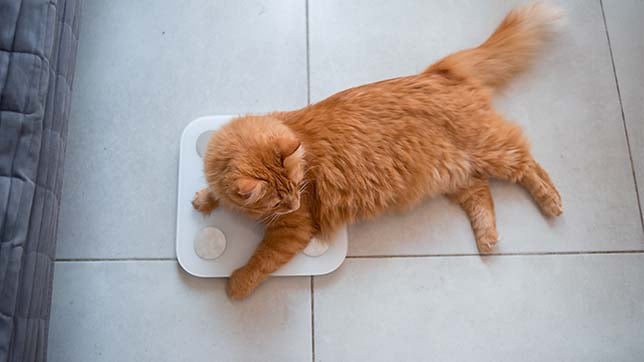11th February 2022
How to weigh your pet at home
Ever wondered if your pet is the right weight? Keeping track of your pet’s weight is really important, especially with the growing problem of obesity in pets in the UK. Regularly weighing your cat or dog can help ensure you are doing all you can to keep them happy and healthy and can even help determine how much they should be fed or help detect early signs of serious illnesses.
Most owners go by appearance, which can be effective in checking their body score, but a guessed weight should never determine their diet plan. From mischievous Moggies to giant Great Danes, we want to help you learn how to weigh your pet at home.
How to weigh a small pet at home
If you have a kitten or puppy or even a small pet breed, you might be able to weigh them just by using your kitchen or bathroom scales… if they stay still for long enough! If this isn’t an option, you might be able to buy an electronic pet scale online to be able to track their weight.
The vets at Joii suggest using the following process to weigh your pet:
- Place your bathroom scales on the floor
- Weigh yourself and record your weight
- Pick up your pet (if you can) and step on the scales again
- Subtract your weight from your combined weight
- This will give you your pet’s weight

How to weigh a bigger pet
If you have a giant dog or a larger breed of cat, you might be better off taking them into a vet practice or pet shop to weigh them safely. If you try to pick up your heavy breed of pet, you might end up hurting yourself or accidentally injuring them in the process so it’s best to use professional scales.
Some practices have large, accurate scales in the reception area and their weight can be passed on to your vet to be added to their record. This can allow them to spot any changes in their weight over time.
How else can i check my pet is a healthy weight?
You could give your pet a quick check over at home by using a body conditioning score which involves looking at and feeling the ribs and waist of your pet.
You can give your pet a body conditioning check at home by:
- Looking at your pet’s body from the side and from above. They should have a noticeable waist that tucks in with a small fat pad on the tummy.
- Feel along your pet’s back and sides where you should easily be able to feel their ribs, spine and hips but they shouldn’t poke out.
Your vet will also be able to get a much better idea of whether your pet is doing well during their routine check-ups. If you have any concerns over your pet’s weight, contact your vet immediately.
Looking for more cat advice?
We’ve written some handy cat advice guides, to help you unlock the secrets of your mysterious moggy.
Need cat insurance?
Cat insurance can help cover the cost of veterinary treatment if your cat gets injured or falls ill.
We know pets
Our pets are part of the family. To achieve our vision of a better future for pets everywhere, we work with our partners, vets, and other veterinary professionals who are pioneering the latest advancements in animal care. Our campaigns, articles, and events are crafted to support, educate, and celebrate pet owners, while our policies are designed to provide peace of mind at an affordable price.
Yet our policies don’t just protect against the unexpected – they have purpose, too.
Since we were founded over 25 years ago, we've provided industry-leading policies that protect the nation’s pets, while also making a difference to animal welfare and our planet. Thanks to you, our policyholders, we've donated over £9 million to more than 830 animal welfare charities and conservancies, helping to support vulnerable pets and wildlife around the world.
We’re proud to be wildly different. Are you?
